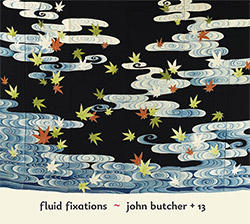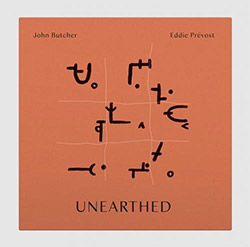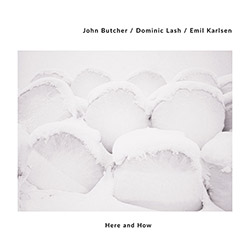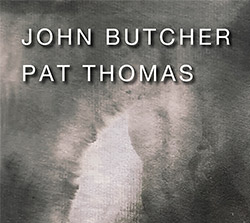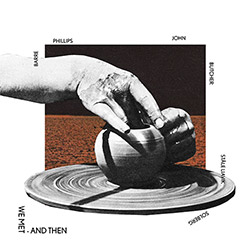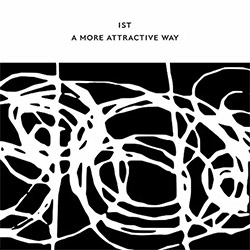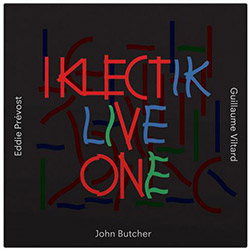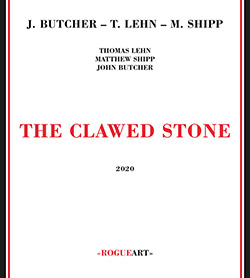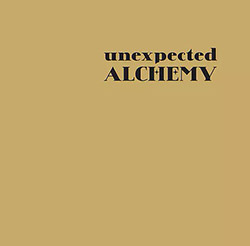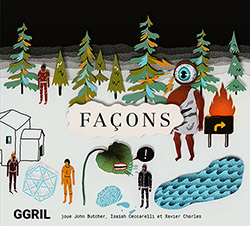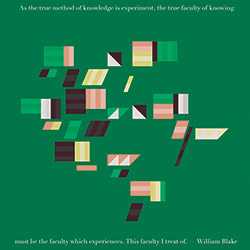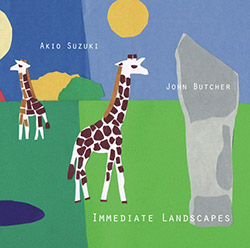
At the same event in Scotland that John Butcher recorded his excellent "Resonant Spaces" album, he also joined forces with sound artist Akio Suzuki on a variety of objects and sound devices to record the first 5 tracks of this unusual album of very free improv, the last track by the duo recording at the 2015 Ftarri Festival at SuperDeluxe in Tokyo.
In Stock
Quantity in Basket: None
Log In to use our Wish List
Shipping Weight: 3.00 units
Sample The Album:
Akio Suzuki-pebbles, glass plate, sponge, pocket bottle, voice ANALAPOS, brass plate, cardboard box, wood screws, bamboo stick, metal plate, noise whistle, swizzle sticks
John Butcher-tenor saxophone, soprano saxophone
Click an artist name above to see in-stock items for that artist.
UPC: 4589740822029
Label: Ftarri
Catalog ID: ftarri-987
Squidco Product Code: 24828
Format: CD
Condition: New
Released: 2017
Country: Japan
Packaging: Cardboard Gatefold
Recorded at the Ftarri Festival, in SuperDeluxe, Roppongi, Tokyo, Japan, in November, 2015, by Chihei Hatakeyama, and in Scotland & Orkney in June 20016 on the Arika "Resonant Spaces" Tour.
"Sound artist Akio Suzuki crisscrosses the world with his self-made instruments. British tenor/soprano sax player John Butcher is a leading figure in improvised music. These two musicians have been carrying out duo performances since 2002. The six tracks on this CD are recordings of their duos in Scotland in 2006 and Tokyo in 2015.
In June 2006, an event was held in which Suzuki and Butcher visited and performed in places around Scotland that have highly distinctive acoustic characteristics. Butcher's solo performances from this event were released in the CD Resonant Spaces (Confront, 2008). Recordings had also been made of the duo performances, and these are being released for the first time on this CD. The fascinating performances on these five tracks, each of which is 5-8 minutes long, made use of the special acoustic environments of five locations: the underground Wormit Reservoir in Fife; the Hamilton Mausoleum in Hamilton, well known as a manmade structure with long reverberation; the gigantic Smoo Cave in Durness; the large Tugnet Ice House in Spey Bay; and the Lyness Oil Tank in the Orkney Islands, which was used during World War Two.
Suzuki and Butcher also performed together nine and a half years later, in November 2015, at Ftarri Festival2015, held at SuperDeluxe, Tokyo. In this 27-minute-long performance, they exchange myriad sounds in a flexible, spontaneous manner."-Ftarri

The Squid's Ear!
Artist Biographies
• Show Bio for Akio Suzuki "Akio Suzuki is known as a pioneer of sound art, but the breadth of his activities and the form of his works far exceeds the normal boundaries of sound art. It is perhaps more as a "quester after sound and space" that he has received the most attention from artists in many fields.Suzuki's journey as an artist began in 1963 with a performance at Nagoya station, in which he threw a bucket full of junk down a staircase. The inspiration behind this performance - the idea that if one were to hurl an object down a well-balanced stairway, a pleasant rhythm might be the result - took the desire to "listen" as its subject. That desire to hear, to listen has remained the one constant in Suzuki's stance as an artist. During the sixties, Suzuki's sense of playfulness led him to undertake a series of Self-Study Events, where he explored the processes of "throwing" and "following", taking the natural world as his collaborator. The experiences he gained in these events led him in the seventies to invent an echo instrument he named Analapos. The instrument's structure resembles that of two mirrors facing each other, reflecting into infinity. As an extension of the principles underlying Analapos, Suzuki constructed the Hinatabokko no kukan (Space in the Sun) in 1988. This space consists of two huge parallel walls, in between which the artist can sit all day and purify his hearing by listening to the reflected sounds of nature. This space leads the artist to discover a new method of listening. Suzuki himself comments, "Sound, which had been conceptually imprisoned in various spaces, is freed to circle the world." From the late seventies and through the eighties, Suzuki also developed a form of performance he refers to as Conceptual Soundwork. Applying a number of self-imposed, simple and austere rules, he uses objects close at hand in a mode of "intellectual play". While these events do on the one hand express a critique of meaningless improvised performance, at the same time Suzuki is constantly aware of the audience's process of listening and he attempts to create contemporaneous connections with the site of performance. It was around this time that Suzuki began to travel frequently to the US and Europe, and his performances at leading music festivals, Festival d'Automne (Paris, 1978) and Documenta 8 (Kassel, 1987) were rapturously received. As sound art enjoyed a period of prosperity in the nineties, Suzuki was given the chance to create many installations, particularly in Berlin. Worthy of special note were his soundless installations, such as Otodate (Echo point, 1996) in Berlin, Enghien-les-Bains (since 1997, http://www.insitu-enghien.org/) and Strasbourg; Hana (Flower, 1997) at the Stadtgalarie Saarbrucken; and Pyramid (1999) which involved people excavating sounds. These soundless pieces were not designed to critique the old perceptual theories of music, rather they questioned the very location of music. Through their encounter with these works, the past experiences and memories of viewers were reconstructed as new experiences. This process was fundamental to the action of "listening" to the works. From the late seventies and through the eighties, Suzuki also developed a form of performance he refers to as Conceptual Soundwork. Applying a number of self-imposed, simple and austere rules, he uses objects close at hand in a mode of "intellectual play". While these events do on the one hand express a critique of meaningless improvised performance, at the same time Suzuki is constantly aware of the audience's process of listening and he attempts to create contemporaneous connections with the site of performance. It was around this time that Suzuki began to travel frequently to the US and Europe, and his performances at leading music festivals, Festival d'Automne (Paris, 1978) and Documenta 8 (Kassel, 1987) were rapturously received. As sound art enjoyed a period of prosperity in the nineties, Suzuki was given the chance to create many installations, particularly in Berlin. Worthy of special note were his soundless installations, such as Otodate (Echo point, 1996) in Berlin, Enghien-les-Bains (since 1997, http://www.insitu-enghien.org/) and Strasbourg; Hana (Flower, 1997) at the Stadtgalarie Saarbrucken; and Pyramid (1999) which involved people excavating sounds. These soundless pieces were not designed to critique the old perceptual theories of music, rather they questioned the very location of music. Through their encounter with these works, the past experiences and memories of viewers were reconstructed as new experiences. This process was fundamental to the action of "listening" to the works." ^ Hide Bio for Akio Suzuki • Show Bio for John Butcher "John Butcher's work ranges through improvisation, his own compositions, multitracked pieces and explorations with feedback and extreme acoustics.Originally a physicist, he left academia in '82, and has since collaborated with hundreds of musicians - Derek Bailey, John Tilbury, John Stevens, The EX, Akio Suzuki, Gerry Hemingway, Polwechsel, Gino Robair, Rhodri Davies, Okkyung Lee, John Edwards, Toshi Nakamura, Paul Lovens, Eddie Prevost, Mark Sanders, Christian Marclay, Otomo Yoshihide, Phil Minton, and Andy Moor - to name a few. He is well known as a solo performer who attempts to engage with the uniqueness of place. Resonant Spaces is a collection of site-specific performances collected during a tour of unusual locations in Scotland and the Orkney Islands.His first solo album, Thirteen Friendly Numbers, includes compositions for multitracked saxophones, whilst later solo CDs focus on live performance, composition, amplification and saxophone-controlled feedback. HCMF has twice commissioned him to compose for his own large ensembles. Other commissions include for Elision (Australia), the Rova (USA) & Quasar (Canada) Saxophone Quartets, reconstructed Futurist Intonarumori (USA), "Tarab Cuts" (based on pre-WWII Arabic recordings, and shortlisted for the 2014 British Composer's Award) and "Good Liquor .." for the London Sinfonietta. In 2011 he received a Paul Hamlyn Foundation Award for Artists. Recent groupings include The Apophonics with Robair and Edwards, Anemone with Peter Evans, Plume with Tony Buck & Magda Mayas and a trio with Okkyung Lee & Mark Sanders.Butcher values playing in occasional encounters - ranging from large groups such as Butch Morris' London Skyscraper and the EX Orkestra, to duo concerts with David Toop, Kevin Drumm, Claudia Binder, Paal Nilssen-Love, Thomas Lehn, Fred Frith, Keiji Haino, Ute Kangeisser, Matthew Shipp and Yuji Takahashi." ^ Hide Bio for John Butcher
7/10/2024
Have a better biography or biography source? Please Contact Us so that we can update this biography.
7/10/2024
Have a better biography or biography source? Please Contact Us so that we can update this biography.
Track Listing:
1. Reservoir 8:09
2. Mausoleum 6:12
3. Cave 5:17
4. Ice House 6:34
5. Oil Tank 6:17
6. Night Club 26:52
Improvised Music
Free Improvisation
Duo Recordings
London & UK Improv & Related Scenes
Japanese & Asian Improv/Rock
Objects and Home-made Instruments
John Butcher
Staff Picks & Recommended Items
Search for other titles on the label:
Ftarri.



